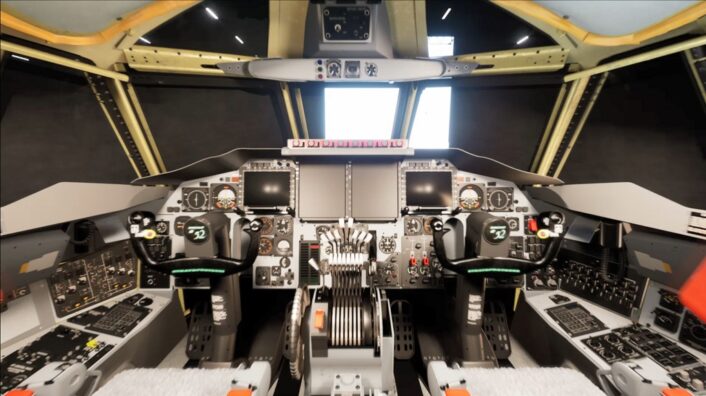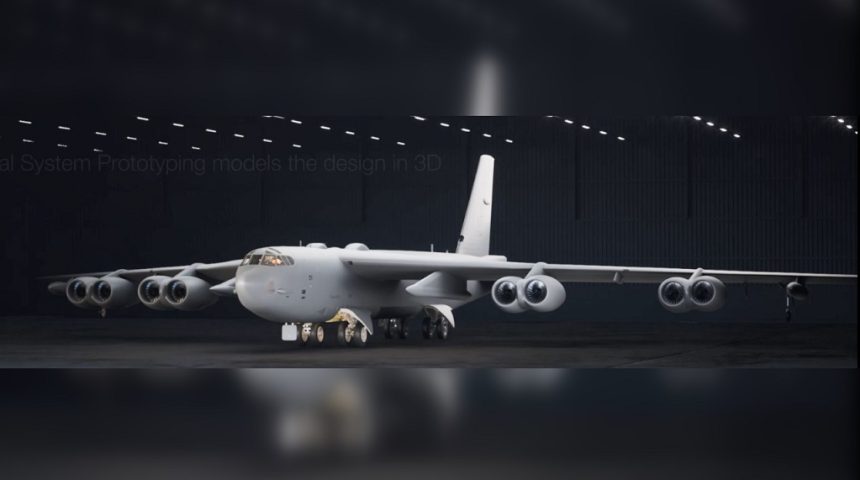Even if the first flight of the upgraded bomber is still years away, we now know how it will look like after the largest modification program in its history.
As we extensively reported, the B-52 Stratofortress is about to undergo the largest modification program in its history. New images, released by Boeing to Air & Space Forces Magazine, show how the upgraded bomber will look like after the radar and engine replacements, both on the exterior and in the cockpit. The image was rendered from a digital prototyping model and is likely to closely resemble the final version.
One of the first features that is quickly noticeable is the larger diameter of the Rolls-Royce F130’s fan and the new engine nacelles, which we already saw in the video released by Boeing for the completion of the wind tunnel testing of the scale model. The new nacelles are positioned higher and farther forward than the current ones used for the Pratt & Whitney TF-33 engines with which the B-52 has been flying since 1962.
The new F130 engines will increase the range of the BUFF (Big Ugly Fat Fellow), enhance field performance, improve fuel economy, and reduce maintenance and logistics costs and burdens. Some have been wondering why the U.S. Air Force did not choose to use four larger turbo fans instead of eight smaller ones. Among the reasons that barred the four-engine solution there are the limited takeoff clearance they would have provided and the need for a more radical redesign of the engine/wing/pylon interface, resulting in a more complex and riskier conversion.
With the installation of the new radar, a modified variant of the F/A-18EF Super Hornet’s APG-79 AESA radar, the B-52 is also getting a facelift, with a more streamlined profile and a cleaner look. In fact, as already reported, the blisters that currently house the AN/ASQ-151 Electro-Optical Viewing System (EVS) since the 1970s will be removed. The EVS was used to help crews fly safely at very low altitudes, but it was largely supplanted by the Litening and Sniper targeting pods installed on pylons under the bomber’s left wing.

The APG-79 will give the B-52s greatly improved radar range and situational awareness, while taking less space then the older mechanically scanned radar. That free space will create growth space for electronic warfare functions, said Col. Louise Ruscetta, senior materiel leader for the B-52. Also, the capability to slave the targeting pod to the radar and vice versa will be very useful for target acquisition and identification, including aircraft, among other things.
The last major external difference is the presence of two large humps over the fuselage, near the wing roots. A Boeing spokesperson said the humps are not new and not part of their upgrade program, however, when pressed, hinted that they could host classified equipment. Based on shape and position, it is being reported that they could be associated with wideband satellite communications systems.
As a complement to the new engines and radar, the BUFF is also getting a cockpit upgrade, with “new 8 x 10 digital displays, hybrid mechanical-to-digital throttle system, new data concentrators units (2x), new engine fault maintenance recorder, new engine air data system (and) modified system panels, as well as structural, electrical, pneumatic and hydraulic updates associated with this modernization effort”, according to Boeing.
The four color multifunction displays will replace most of the instruments and present the flight status and engine information, but a part of the old analog gauges will still be retained, like the attitude indicator, for an instance. A crew member station is also being removed, with the total crew reduced from five to four members. As we reported, the B-52 Formal Training Unit at Barksdale is already training crews with a new curriculum designed to fly the B-52 with four people instead of five.
New engines were the main reason the B-52G was redesignated as B-52H in 1962. As already reported, the Air Force will designate the upgraded bomber either B-52J or B-52K, however a final decision has not been taken yet. Col. Ruscetta said, given that the combined engine/radar program represents “the largest modification in the history” of the B-52, a new designation is likely, however there might be an interim designation because the radar will be installed before the engines. This way, a change in operating and maintenance manuals and documentation will be required after the radar upgrade and then once again after the engines are replaced.









